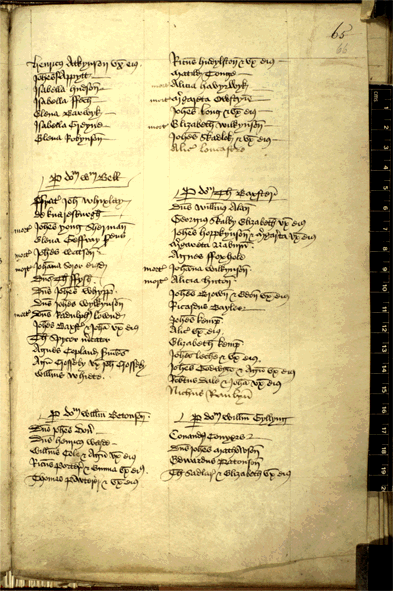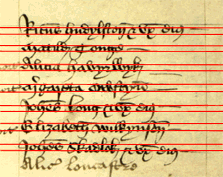
This part of the Register of the York Corpus Christi Guild is a list of new members, and something of a Roll of Honour, as the Guild was socially very prestigious, though that did not prevent servants like Elena Geffray (line 12) or Agnes Copland (line 21) joining it.

The page has been frame-ruled into two columns. The gutter between the two columns is roughly equivalent in size to the lefthand margin. The margin at the outer edge of the page is wider than the margin at the binding. Top and bottom margins are also quite large.
The scribe has not managed to keep the names in both columns on quite the same level as each
other, though they are not far out, and would have looked more balanced before the additions.
Spaces between the lines are about twice as wide as the
the width between headline and baseline. This leaves room for ascenders and descenders,
which despite the rather untidy effect, do not often tangle with each other.
The names are organised into groups under the name of their sponsor, which is underlined:
Both Christian and surnames begin with a capital letter.
Christian names are heavily abbreviated. This is common
in medieval documents, whether they be wills, charters, or household and business accounts.
Occasionally the person's occupation is added to his name.
This was customary in the Freemen's Rolls, which recorded the admission of Freemen to the City. This
happened about the age of 21: a man or woman was not allowed to trade in their own right
unless they were a Freeman. Often (like John Nappett in line 2) they join the Corpus Christi
Guild at the same time.
Return to Index Page.
© MEG TWYCROSS 2000
Gutter and lefthand margin are used for later annotations: on this page we are told
which of the listed members have since died. The writing looks identical with that of the main
hand, so presumably they did this fairly near to the date of their enrolment.

However, the spaces between groups of members have also been used to add names,
by another hand writing in a paler ink.



The names are usually completed with a dash or other flourish.

Sometimes this is made to look like an abbreviation mark, though there is no credible
expansion possible here.

Sometimes a genuine abbreviation is used as a finishing flourish.
This is eius.

As you have seen on the previous page,
there are distinctive forms for capital letters: 'Lower-case' letter:




Capital letter:




Though sometimes they are merely more elaborated versions of the
lower-case letters: 'Lower-case' letter:




Capital letter:





Ricardus, 'Richard'.

Johannes, 'John'. 
Margareta, 'Margaret'.

Radulphus, 'Ralph'. 
Willelmus, 'William'.

Matilda, 'Matilda/Maud'.

John Yong is a shearman: he trims the nap of cloth after the
first weaving. 
Thomas Spicer is a merchant. His family may once have traded
exclusively in spices, hence his surname, but by the mid fifteenth century surnames have become
less descriptions and more family names.
Return to Question Page.